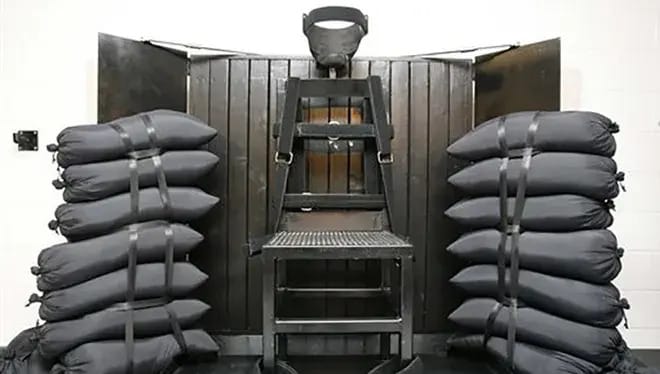- The Medicine & Justice Project
- Posts
- Giving Up the Pretense of "A Quiet Death"
Giving Up the Pretense of "A Quiet Death"
With two firing squad executions scheduled this week, the idea that executions can be anything other than homicide by another name appears to be dying.

Utah’s firing squad chamber.
For most of America’s history, its methods of capital punishment could be described as a search to meet its Eighth Amendment burden of killing people softly. The electric chair replaced hanging on the premise it could kill the condemned instantly; gas chambers were designed to render unto them a peaceful slumber; lethal injection promised the quick and painless sleep of surgery. If we must take a life, the nation has always concluded, we must at least try to make it humane.
Unless that’s too hard, apparently.
Earlier this year, Idaho introduced legislation to make the firing squad its primary means of carrying out capital punishment, following a marathon attempt at executing Thomas Creech via lethal injection. Now South Carolina seeks to do the same with Friday’s scheduled execution of Brad Sigmon, the nation’s first firing squad execution since Utah killed Ronnie Lee Gardner in 2010.
While the firing squad is older than the gun itself, the modern incarnation involves much more than the ad-hoc designs of which Goya and Dostoevsky attest. South Carolina law doesn’t require its exact protocol be made public, but a USA Today reporter was able to coax some details from the state’s Department of Corrections:
There will be three members to the firing squad team − voluntary corrections staff − and all will stand behind a wall with loaded rifles 15 feet from the inmate. The wall will have an opening that that won't be visible from the witness room.
"The inmate will be strapped into the chair, and a hood will be placed over his head," the department said. "A small aim point will be placed over his heart by a member of the execution team. After the warden reads the execution order, the team will fire. After the shots, a doctor will examine the inmate. After the inmate is declared dead, the curtain will be drawn and witnesses escorted out."Witnesses to the execution, which typically involve family members of both the inmate and victim, members of the news media, attorneys, and prison staff "will see the right-side profile of the inmate."
To be clear, the push to bring back firing squads doesn’t come from left field. Amherst law professor Austin Sarat, who has studied all-method botched executions more thoroughly than any person alive, concluded that the modern firing squad resulted in the fewest botched executions of any method available; he could not find a botched execution by firing squad since 1890. (Detractors often point out that cutoff just excludes two botched firing squad executions; I’ve noted my own issues with Sarat’s study before.) Sigmon himself elected the firing squad based on decades of reporting that lethal injection could be “torturous,“ following two botched South Carolina executions.
What the firing squad is not, however, is the sanitized, medicalized death lethal injection—and its potential replacement nitrogen asphyxiation—were proposed to be. Gardner’s brother Randy said of photos from his autopsy:
“My brother's chest was blown wide open, I have autopsies of my brother's body…He had four holes in his chest and it just blew his whole back out. Why would you want to do that, why would you want to volunteer for stuff like that?”
Nor does the firing squad pretend to be painless in the way lethal injection and nitrogen hypoxia were designed to be. The pathologist who conducted that autopsy, Dr. Jonathan Arden, noted that “If the mechanism of death in firing squad execution is heart stoppage, then the state must concede that the prisoner would remain conscious for a minimum of about 15 seconds after being shot, during which time the person would experience excruciating pain.”
None of these are the prime mover behind the switch; it’s a matter of logistics. More than 15 years after major manufacturers bowed out and with mom-and-pop compounding pharmacies under increased pressure, states are having a harder and harder time finding and keeping the drugs needed to conduct lethal injection, forcing them into either the expensive retrofitting—and inconvenient early reporting—involved in nitrogen hypoxia or a return to earlier, less aesthetically pleasing means of homicide. (This philosophical return to transparency doesn’t imply a turn toward procedural transparency: South Carolina courts obscured Gardner’s autopsy photos from the public version of Sigmon’s filings, calling them “highly inflammatory or otherwise potentially harmful.”)
None of this poses an Eighth Amendment concern for the Roberts Court. The Supreme Court held in 2019’s Bucklew v. Precythe that painlessness is not a requirement of an Eighth Amendment-compliant execution method, and that only “superadding“ pain and suffering would constitute cruel and unusual punishment. In keeping with the alternative-method requirement in Baze v. Rees and Glossip v. Gross—and with the Court’s history of never ruling an execution method unconstitutional—Gorsuch’s majority opinion limited questions of “superaddition“ to comparisons with another method.
Lawmakers have taken the courts’ green light for what it is. After introducing a bill to make it an official alternative to lethal injection, state Representative Paul Ray conceded that the method “may seem a little more barbaric, but it does what we need it to do in the end.“
Reply